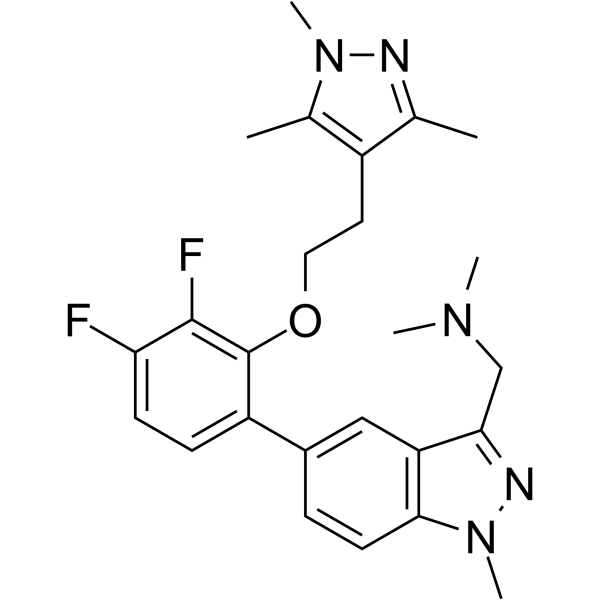Physicochemical Properties
| Molecular Formula | C25H29F2N5O |
| Molecular Weight | 453.53 |
| Exact Mass | 453.234 |
| Elemental Analysis | C, 66.21; H, 6.45; F, 8.38; N, 15.44; O, 3.53 |
| CAS # | 2059148-82-0 |
| PubChem CID | 132274735 |
| Appearance | Colorless to light yellow solid powder |
| Density | 1.2±0.1 g/cm3 |
| Boiling Point | 566.9±50.0 °C at 760 mmHg |
| Flash Point | 296.6±30.1 °C |
| Vapour Pressure | 0.0±1.6 mmHg at 25°C |
| Index of Refraction | 1.595 |
| LogP | 3.73 |
| Hydrogen Bond Donor Count | 0 |
| Hydrogen Bond Acceptor Count | 6 |
| Rotatable Bond Count | 7 |
| Heavy Atom Count | 33 |
| Complexity | 642 |
| Defined Atom Stereocenter Count | 0 |
| InChi Key | SOXNKJCQBRQUMS-UHFFFAOYSA-N |
| InChi Code | InChI=1S/C25H29F2N5O/c1-15-18(16(2)31(5)28-15)11-12-33-25-19(8-9-21(26)24(25)27)17-7-10-23-20(13-17)22(14-30(3)4)29-32(23)6/h7-10,13H,11-12,14H2,1-6H3 |
| Chemical Name | 1-[5-[3,4-difluoro-2-[2-(1,3,5-trimethylpyrazol-4-yl)ethoxy]phenyl]-1-methylindazol-3-yl]-N,N-dimethylmethanamine |
| Synonyms | IMP1088; IMP 1088; IMP-1088 |
| HS Tariff Code | 2934.99.9001 |
| Storage |
Powder-20°C 3 years 4°C 2 years In solvent -80°C 6 months -20°C 1 month |
| Shipping Condition | Room temperature (This product is stable at ambient temperature for a few days during ordinary shipping and time spent in Customs) |
Biological Activity
| Targets | HsNMT1 ( IC50 < 1 nM ); HsNMT2 ( IC50 < 1 nM ); HsNMT1 ( Kd < 210 pM ) |
| ln Vitro | IMP-1088 (1-1000 nM) has an IC50 of 17 nM and inhibits the virus-induced cytopathic effect (CPE) in a dose-dependent manner. With an IC50 of 5.8 nM, IMP-1088 (125 nM) completely inhibits novel infectious viruses. In primary human bronchial epithelial cells (hBEC) infected with rhinovirus RV-A1 (MOI 5), IMP-1088 (1-1000 nM) suppresses single cycle replication and stops the formation of infectious virus for a duration of 7 hours. Even when added up to three hours after infection, IMP-1088 dramatically reduces the generation of infectious viruses[1]. In enriched samples, IMP-1088 (50 nM) considerably reduces the enrichment of several N-myristoylated proteins[1]. By preventing virus assembly in HeLa cells infected with rhinovirus RV-A16 (MOI 20) for six hours, IMP-1088 (500 nM) reduces the generation of infectious rhinovirus particles[1]. NMT activity fully recovers in 24 hours and IMP-1088 (0.24 nM-1 µM; for 24 hours + 24 hours washout) has no long-term effect on cell viability[1]. IMP-1088 effectively inhibits co-translational myristoylation of a virus-specific encoded protein (VP0), hence blocking a crucial stage in viral capsid construction. IMP-1088 does not impede the translation of rhinovirus polyprotein or the synthesis of viral RNA[1]. |
| References |
[1]. Fragment-derived Inhibitors of Human N-myristoyltransferase Block Capsid Assembly and Replication of the Common Cold Virus. Nat Chem. 2018 Jun;10(6):599-606. |
Solubility Data
| Solubility (In Vitro) | DMSO : ~100 mg/mL (~220.5 mM) |
| Solubility (In Vivo) |
Solubility in Formulation 1: ≥ 2.5 mg/mL (5.51 mM) (saturation unknown) in 10% DMSO + 40% PEG300 + 5% Tween80 + 45% Saline (add these co-solvents sequentially from left to right, and one by one), clear solution. For example, if 1 mL of working solution is to be prepared, you can add 100 μL of 25.0 mg/mL clear DMSO stock solution to 400 μL PEG300 and mix evenly; then add 50 μL Tween-80 to the above solution and mix evenly; then add 450 μL normal saline to adjust the volume to 1 mL. Preparation of saline: Dissolve 0.9 g of sodium chloride in 100 mL ddH₂ O to obtain a clear solution. Solubility in Formulation 2: ≥ 2.5 mg/mL (5.51 mM) (saturation unknown) in 10% DMSO + 90% (20% SBE-β-CD in Saline) (add these co-solvents sequentially from left to right, and one by one), clear solution. For example, if 1 mL of working solution is to be prepared, you can add 100 μL of 25.0 mg/mL clear DMSO stock solution to 900 μL of 20% SBE-β-CD physiological saline solution and mix evenly. Preparation of 20% SBE-β-CD in Saline (4°C,1 week): Dissolve 2 g SBE-β-CD in 10 mL saline to obtain a clear solution. Solubility in Formulation 3: ≥ 2.5 mg/mL (5.51 mM) (saturation unknown) in 10% DMSO + 90% Corn Oil (add these co-solvents sequentially from left to right, and one by one), clear solution. For example, if 1 mL of working solution is to be prepared, you can add 100 μL of 25.0 mg/mL clear DMSO stock solution to 900 μL of corn oil and mix evenly. (Please use freshly prepared in vivo formulations for optimal results.) |
| Preparing Stock Solutions | 1 mg | 5 mg | 10 mg | |
| 1 mM | 2.2049 mL | 11.0246 mL | 22.0493 mL | |
| 5 mM | 0.4410 mL | 2.2049 mL | 4.4099 mL | |
| 10 mM | 0.2205 mL | 1.1025 mL | 2.2049 mL |
